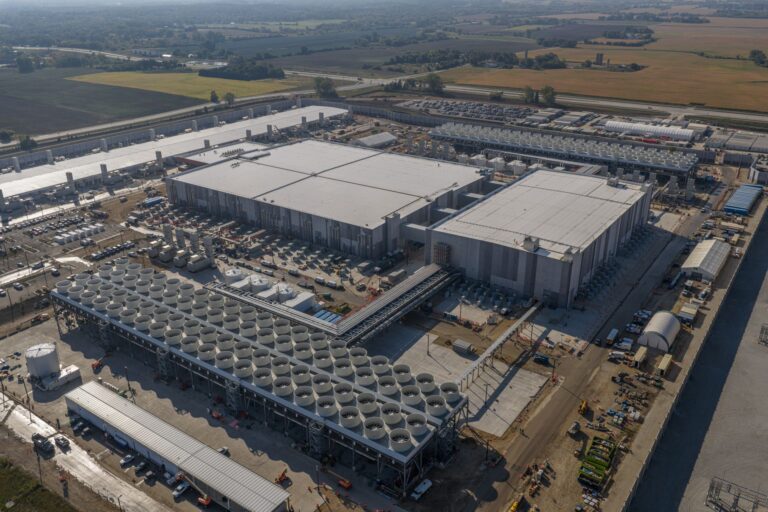Microsoft is opening the largest AI datacenter ever built in Wisconsin. The 315-hectare Fairwater complex serves as the foundation for a global network of purpose-built AI factories that collectively function as a massive AI supercomputer.
Fairwater runs on Nvidia GB200 servers in a configuration that includes 72 Blackwell GPUs per rack. Each rack generates 1.8 terabytes of GPU-to-GPU bandwidth and gives each GPU access to 14 terabytes of shared memory. This architecture processes 865,000 tokens per second—the highest processing level of any cloud platform. Microsoft claims this makes it the world’s most powerful AI datacenter.
The networking infrastructure combines NVLink and NVSwitch technology at the rack level with 800 Gbps InfiniBand and Ethernet fabrics between racks. The design eliminates congestion by providing each GPU with full-line rate communication with all other GPUs.
To minimize physical latency, Microsoft is implementing a dual-layer datacenter design. Racks connect not only to adjacent systems, but also to hardware on other floors. This approach significantly reduces the physical distance between components.
A new generation of datacenters
Microsoft is launching a wave of new AI facilities worldwide, with Wisconsin’s Fairwater datacenter taking the crown. The complex spans 315 hectares and houses three buildings with a combined floor area of 1.2 million square meters. Its construction required 75 kilometers of foundation piles, 12 million kilograms of steel, and 193 kilometers of underground cables.
This facility is fundamentally different from traditional cloud datacenters. Whereas ordinary datacenters run much smaller, independent workloads such as websites and email, Fairwater functions as one giant AI supercomputer. The system connects hundreds of thousands of Nvidia GPUs via a flat network that delivers ten times the performance of the world’s fastest supercomputer.
In addition to Wisconsin, Microsoft is announcing simultaneous projects in Norway with nScale and Aker, plus a collaboration in the United Kingdom for Europe’s largest supercomputer. These investments represent tens of billions of dollars and will integrate seamlessly with Microsoft’s global cloud network of more than 400 datacenters.
Sustainability through closed cooling
The extreme computing power requires advanced cooling. Fairwater implements a closed liquid cooling system that fills water only once and then reuses it without evaporation. The complex features the world’s second-largest water-cooled chiller installation with 172 fans measuring six meters in diameter.
More than 90 percent of the datacenter capacity uses this system, drastically reducing water consumption. The remaining 10 percent of traditional servers only switch to water cooling on extremely hot days.
Towards a distributed AI network
Microsoft’s vision goes beyond individual facilities. The company is developing a Wide Area Network that connects multiple AI datacenters into a single distribution network. This approach eliminates the limitations of single locations and creates opportunities for large-scale distributed training.
The storage system supports this ambition with Azure Blob Storage accounts that can handle more than 2 million read/write transactions per second. Wisconsin’s storage infrastructure alone covers five football fields in length.
Fairwater represents a fundamental shift in infrastructure design. Microsoft is rearchitecting every layer of the cloud stack, from silicon to software, to optimally support AI workloads. The result is not a collection of servers, but a purpose-built system where hardware and software function as a single entity.
Tip: Microsoft purchases 50 hectares for datacenter expansion in Middenmeer
